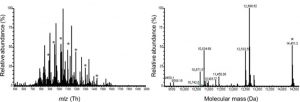Alpha-Synuclein Proteoforms in Neurodegeneration
In collaboration with:
Description: Truncated forms of ⍺-synuclein have a role in Parkinson’s disease (PD). Truncated ⍺-synuclein is found in Lewy bodies purified from PD brain and is known to promote the rapid formation of ⍺-synuclein aggregates in vitro and in vivo. ⍺-synuclein cleavage at the C-or N-terminus has been shown to differentially affect the kinetics of aggregation and spread of ⍺-synuclein pathology across neurons of the brain, which consequently may impact the progression of PD. To date, all identified ⍺-synuclein truncation products in the PD brain have an intact non-amyloid component (NAC) domain, which is a 30 amino acid domain of ⍺-synuclein required for aggregation. Overall, aberrantly truncated forms of ⍺-synuclein are thought to be drivers in the formation of Lewy-pathology but a historical reliance on bottom-up approaches have resulted in ambiguity in characterization of Lewy proteoforms. ⍺-synuclein pathology has been detected in the gastrointestinal (GI) tract years prior to the clinical onset of PD motor symptoms. There is also evidence that ⍺-synuclein aggregates can travel via nerves from gut to the brain, and pathological staging of the PD brain supports a GI origin to this disease. As a result, the GI tract has been an area of intense focus inthe search for biomarkers of PD. As Collaboration and Service Project 17, we recently found that truncated ⍺-synuclein proteoforms were abundant in the vermiform appendix. The ⍺-synuclein truncation products in the appendix are prone to rapid aggregation, and highly aggregated forms (detergent insoluble) were more abundant in PD patients. In a large epidemiological analysis, the Labrie lab found that an appendectomy was associated with a 20% decrease in risk for PD. Thus, the appendix may be a tissue site that contributes to the initiation and early development of PD and could be useful for developing a method to screen ⍺-synuclein proteoforms for PD diagnostics.
Top-down mass spectrometry of α-synuclein truncation products in the human appendix showing MS1 (left) and MS2 (right).
Project status: On going
Publications:
The vermiform appendix impacts the risk of developing Parkinson’s disease. Bryan A. Killinger et al.
Congress Presentations: none
Spinoff funding: DOD PD170089





Comments are closed.